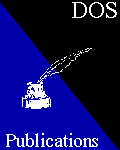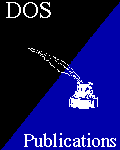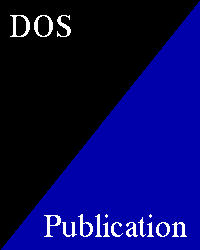
DOS
Betamax's
DOS PUBLICATIONS
PROGRAMMING


|
|
Doctor DOS Betamax's |
DOS PUBLICATIONS
|
The following present books regarding programming
for DOS or its software. Be aware that other books
at this site may contain programming information.
INFORMATION AND IMAGES BELOW MAY NOT BE
REPRODUCED WITHOUT PERMISSION FROM THE AUTHOR ©

 |
Advanced dBASE III Plus Programming and Techniques 1987 by Miriam Liskin ISBN: 0-07-8811249-6 An older book about program design for data handling. Structure and strategy, memory variables, custom screens and more are discussed as a lead up to simple first programs. Debugging and testing are covered, then techniques for optimising the system are given. These include data validation, providing more control, networking and security, and on-screen help. Hefty appendixes cover commands and syntax, functions, configuration, error messages and anomalies. |
|
Advanced MS-DOS Programming 1988 by Ray Duncan ISBN: 1-55615-157-8 (Second Edition) A Microsoft book intended for advanced users and for programmers, this book is useful for those coding in Assembly or C. After a short development history and the structure of DOS are discussed, it moves on to files and records, directories, disc internals, memory allocation, interrupt handlers, device drivers and filters. Extensive program function references round out this useful book. This second edition includes up to MS-DOS 4. |
 |
 |
Advanced MS-DOS Batch File Programming 1991 by Dan Gookin ISBN: 0-8306-5745-2 An earlier book on batch files by Dan. Although it won't cover batch-file commands added since this was published, it is still a valuable resource for those that want to automate DOS operations. (No Additional details are available.) |

 |
Batch Files To Go 1990? by Ronny Richardson ISBN: ? Batch-file guru Ronny Richardson has put together 80+ batch files for the user. They may be utilised as is or modified to fit the user's requirements. A disc is included. |
|
Batch Files and Macros Quick Reference 1991 by Timothy Stanley ISBN: 0-8802-2699-4 This is a Que booklet suitable for the beginner or intermediate batch file author. It shows commands and gives a short writeup of each. |
 |

 |
Concise Guide to MS-DOS Batch Files 1994 by Kris Jamsa ISBN: 1-55615-638-3 A wonderful book from batch-file guru Jamsa. Covered are the basics of course, but he goes into advanced concepts such as chaining batch files, using them with DOS macros, and employing DEBUG scripts to enhance the capability of Batch. Also included are Date & Time procedures, backup operations, system configuration screen enhancements and much more. The appendices include Exit Codes for DOS commands and ANSI commands. A recommended publication. |

 |
dBASE IV Programmer's Instant Reference 1989 by Alan Simpson ISBN: 0-89588-538-7 This is a large book for an "Instant Reference", but it has much to cover given dBASE's capabilities. All commands are sorted by category and then alphabetically. Each has a description, syntax, usage, an example and additional tips. A very handy guide for the programmer. |
|
Dissecting DOS: A Code-Level Look at the DOS Operating System 1994 by Michael Podanoffsky ISBN: 0-20162-687-X This book takes programmers through the code-level guts of MS-DOS. It features the complete source code for RxDOS, which emulates and parallels the commercial system. Explained is the architecture, command structure, and operation of DOS processing function calls, file redirection, disk compression, memory management and device drivers. |
 |
 |
DOS and Windows Protected Mode: Programming with DOS Extenders in C 1992 by Al Williams. ISBN: 0-20163-218-7 DOS extenders provide access to memory above 1 MB so programs can use up to 4 gigabytes of memory. This guide teaches the reader to write applications that take full advantage of DOS extenders such as Ergo, Intel, Metaware and Phar Lap. It is detailed with practical source code. Three sections furnish details on extender technology. Section One introduces DOS extenders. Section Two contains programming examples and focuses on the technical aspects of the extenders. Section Three analyses fully-functional extender programs. A disc is included. |
|
DOS Programmer's Reference 1989 by Terry Dettmann ISBN: 0-880228-458-4 (Second Edition) A book for advanced users to understand how DOS works statically and dynamically. It discusses how to gain access to facilities unavailable even in some high-level languages, how to improve memory and program management capabilities, and to be able to build your own library of functions. Devices are covered extensively, along with the DOS/BIOS interface. |
 |
 |
DOS Programming: The Complete Reference 19?? by Kris Jamsa ISBN: 9780078817823 Kris Jamsa has written extensively on the subject of DOS Programming. (No Other Information.) |
|
Dr. Batch File's Ultimate Collection 1993 by Ronny Richardson ISBN: 0-8306-4112-2 Another book from batch-file guru Ronny. This one has over 120 ready-to-use shortcuts and automated operations along with their explanations. A disc includes these and also batch file utilities to facilitate the user's writing and enhancement of DOS batch files. |
 |

 |
Google Hacks 100 Industrial-Strength Tips & Tools 2003 by Tara Calishane and Rael Dornfest ISBN: 0-596-00447-8 A book not about DOS at all, but useful for any user (DOS or not) doing Internet searches. It is invaluable for any person or business that wishes to include Google services on his or her website. (This site combines two of those services for one of its internal search services.) Because the information is so valuable and because the advanced methods incorporate the Perl script language which is available for DOS, it was decided to provide this title here. Note that for non-programmers, there are still many methods that don't use scripting, plus a plethora of tips useful for any Internet search. Beginning with search basics and advancing to more involved methods, the authors describe techniques that allow one to focus searches so as to narrow the results and find desired information faster. The range of customisation available to both the user and web author is quite extensive. Some tips work with other search engines, but most are Google exclusives. Next are described some of Google's data collections and how to search within them. These include images, UseNet newsgroups and news. Beyond the above, developers are taught how to access Google's database of search results for web applications and games, and are given methods through which webpages can achieve better search engine rankings. In the process, the latter improve a page's design for more than just ranking purposes. The phrase "wealth of knowledge" is a cliche that actually applies to this book. One thing that detracts from it though, is an unusual number of grammar errors. Despite these making for a distracting read at times, it is a highly recommended publication. |
|
The Great Book of Batch Jobs 1990 by Samuel Roberts ISBN: 0-91182-705-6 A book devoted to DOS batch programming, it includes many examples that reflect what is being discussed, but starts off with discussing various uses of batch files and then goes on to simple programming. Each batch command DOS makes available is given and shown how to be used, along with programming languages such as DEBUG and BASIC, Variables (replaceable characters) are discussed. All examples are included on the accompanying disc. |
 |

 |
JPEG Still Image Data Compression Standard 1993 by William Pennebaker and Joan Mitchell ISBN: 0-442-01272-1 The publication discusses the ISO JPEG standards DIS 10918-1 and DIS 10918-2. (No further details.) |

 |
MS-DOS Batch File Programming 1990 by Ronny Richardson ISBN: 0-8306-7537-X (Second Edition) A hands-on guide for newbies to writing powerful, time-saving batch files for DOS. Fundamentals and intermediate techniques show how to have DOS do the work for you. Command-by-command tables explain the more intricate scripts in an easy-to-understand format. The book concludes with chapters of instructions for more complicated programming chores using DEBUG. Source code is shown for the latter. |
|
MS-DOS Batch Files 1989 by Kris Jamsa ISBN: 1-55615-235-3 This is a pocket reference with short, concise explanations of the basics of batch files. It's good for those that need fast reminders of how to implement batch procedures. |
 |
 |
MS-DOS Encyclopedia 1988 by Various Authors ISBN: 1-55615-174-8 A Microsoft Press book, it is intended for programmers. It contains a very detailed look at the development of MS-DOS and then moves on to discuss how to write applications for DOS. |

 |
The New Peter Norton Programmer's Guide to the IBM PC and PS/2 1988 by Peter Norton and Richard Wilton ISBN: 1-55615-131-4 (Second Edition) A book detailing the IBM PC series as related to the DOS operating system. Anyone wanting to know about basic computer hardware and DOS hardware calls, interupts and functions will find this book useful even regarding its age. |

 |
1-2-3 Financial Macros 1985 by Thomas Carlton ISBN: 1-88022-168-2 This is an excellent book for those that prefer to create their own spreadsheet shortcuts to avoid mousing through menus for every operation. Although meant for business 1-2-3 users, the principles discussed here can be applied to most spreadhseet programs that have a "Macros" feature, despite the age of this book. Discussed are step-by-step methods to decide when a macro is required and then how to create an appropriate one. |

 |
Programming in dBASE IV 1992 by ? ISBN: ? A software manual, this first introduces the user to programming, then discusses variables and the environment, data types, and controlling the look of a program. Menu desiging and getting user input are next followed by chapters devoted to dealing with data, its processing, and its security and integrity. Debugging a program is discussed at length. Other topics are the Template Language for generating forms, the SQL Language, and how to combine these with dBASE. Commands and Library functions are each covered individually. |

 |
QBasic by Example 1993 by Greg Perry ISBN: 1-56529-439-4 QBasic is the successor of GW-Basic, which was itself a version of BASIC, a computer programming language developed in the 1950s. QBasic has been included with MS-DOS starting with version 5.0. This book explains the workings of the language for beginners, but provides advanced techniques for intermediate and advanced users. Included are mathematical operators, string variables, arrays, subfunctions, graphics and sound, and disc operations. |

 |
Running MS-DOS QBasic 1991 by Michael Halvorson and David Rygmyr ISBN: 1-55615-340-6 For those running MS-DOS 5 or newer, QBasic was available. This book is an instructional on QBasic with exercises & questions, and it provides sample programs. Geared to beginners, it starts with a programming introduction and then moves on to the QBasic language, variables and operators, program flow control, and loops. It then discusses working with files, strings, sound and graphics. A chapter on debugging rounds out this book. Afterward an extensive appendix covers menus & options, character sets, statements & functions, and conversion from GW-BASIC. |

 |
The Ultimate Batch File Book 1995 by Ronny Richardson ISBN: 0-07-912051-2 A top publication from a batch-file master. If you get just one batch file book, make it this one. Ron goes into great detail on each aspect of automating DOS procedures. He includes batch file specifics on DR, MS, Novell, and PC DOSes - and even on OS/2 and Windows. The book has sections discussing advanced batch programming, and it touts the advantages of after-market batch enhancers. A CD is included containing all of those discussed and also all the sample batch files. |
|
Undocumented DOS 1993 by Andrew Schulman and Others ISBN: 0-201-57064-5 Directed at intermediate to advanced DOS programmers, this book has been on recommended lists since it was first published. The book's sub title says a lot: A Programmer's Guide to Reserved MS-DOS Functions and Data Structures. System resources are studied to see what information might be useful to employ in applications. Then programming techniques not often seen elsewhere are discussed. Languages include Assembly, BASIC, C, and Turbo Pascal. Although the book also covers documented DOS functions, it emphasizes undocumented DOS data structures including the Current Directory Structure, Memory Control Blocks, and the Swappable Data Area. Side effects and bugs are discussed, as well. One can expand one's programming horizons with this book; it's a winner. |
 |

 |
Writing MS-DOS Device Drivers 1992 by Robert Lai ISBN: 0-20160-837-5 An introduction to device drivers starts this book and then it provides an in-depth technical treatment of DOS, the PC, and advanced programming skills. It then moves on to present detailed instructions in writing DOS drivers. A selection of device drivers is given for the user to customise for his own use. |
A special thankyou to Colin Conrad and Babs Walker of
Dartmouth, Nova Scotia for book cover scanning work.
Thanks to Richard Bonner of Dartmouth, Nova Scotia
for digital "repairs" to the covers.
Be sure to check
DOS Websites
for links to some of the programs
mentioned in this publications reference.
|
Return to the Books Table of Contents |
Return to the Publications Table of Contents |

|
|